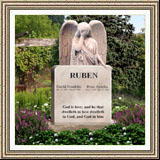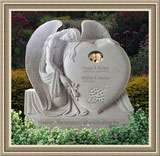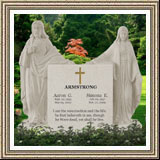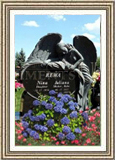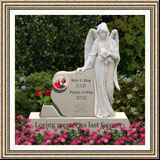|
The Evolution of Greek Sculpture From
600 BCE - 150 BCE
By Sharon L. Green
Greek sculpture "evolved" throughout, and paralleled the
historical significances of this ancient civilization
through three major historical periods. We see how for
the Greeks, art and the events of the day were
significantly entwined.
Each of the three main periods of Greek sculpture
presented its own unique contributions in the art of
sculpting the human form. Ancient Greeks were skilled
craftsmen and incorporated the human appearance into
every aspect of their art from the earliest period the
Archaic, through the middle Classical period, into the
Hellenistic period. Although today we view sculpting as
an art form, in early ancient times the Greeks viewed it
as a learned trade or skill.
Due to the Greek's unique appreciation for sculpture,
this art form was nurtured by the city of Athens, then
the sculptural hub of Greece, as it grew through various
periods. This 'financial support' is why the Ancient
Greeks created vast amounts of sculpture. Art was not so
prolific in areas of the world where it wasn't
profitable. During the Archaic period, from 650 B.C. to
480 B.C., dictators ruled the most powerful Greek
cities. Despite tyrannical rule and political and social
unrest, the arts flourished. The Greek's victory at
Persia's attempt to conquer them in Asia Minor, ushered
in a celebration in Greek Art, "symbolizing the triumph
of civilized peoples over the forces of barbarism". "The
origins of democracy can be traced to Athens in the
years following the fall of the tyrannical Peisistratids
(560-510 BC)".
The earliest full size stone Greek sculptures were one
dimensional nude males and females (kouroi and draped
korai). As beautiful as every sculpture was, they were
being created as grave markers, cult images, and as
dedications for sanctuaries rather than works of art.
Obvious differences in the male and female sculptures of
this period are that males stand nude, forward facing,
one leg forward and arms to the side with clenched
fists, where the females stand with feet together,
always fully clothed with nothing more than their feet
and arms bare. "The difference between the sexes is
striking". Many human sculptures displayed 'the Archaic
smile', which was not created to display emotion, but
rather as a simple, easy solution for the artist
creating the "face". Heavy Egyptian influence is
evidenced by the similarities found in many sculptures
during this period. Some art historians believe Egyptian
artists used a grid system, with spacing between each
line to define their proportions. "Using this same grid
system, artists of the Greek Archaic period produced the
simple and limiting style that led to the creation of
the rigid sculptural forms of that period." Although
bronze casting to create sculptures was discovered in
the middle of this period, it wasn't commonly used until
the 5th century. It's important to note that each stone
sculpture of the Archaic period was richly painted,
enhancing features such as the lips and eyes. Today most
consider them quite beautiful works of art.
Marked by the end of the Persian wars, the second period
in Greek art, the Classical period, spanned from 480
B.C. to 323 B.C. and brought about great changes in
Greek sculpting. This period saw the full development of
the Greek democratic system of government, however by
the late 5th century wars raged between Athens and
Sparta, and the Carthaginians and the Greeks of Sicily
and Italy. Again in the 4th century, Athens, Sparta and
Thebes were warring over control of Greece. Under
Spartan rule, Greece divided and the Macedonian state
rose under Phillip II and his son, Alexander the Great.
The wars occurring during this period influenced the
more life-like, realistic anatomical appearances taken
on by sculptures. Statues with slender athletic torsos
were often posed with war-like stances or grimaced
faces. "Characteristic examples of this trend are two
slightly later works by Praxiteles, the Hermes and the
Conidian Aphrodite. They were considered of unparalleled
beauty by the ancient authors and were copied repeatedly
in later periods."
This classical style is also reflected in two of the
earliest bronze sculptures Tyrannicides Harmodius and
Aristogiton. "Early Classical statues tend to be
dramatic, and to carry with them the impression that
they represent one distinct stage in a series of
events". "In the period from 430 - 400 B.C. sculptors in
particular devoted a great part of their attention to
exploiting the decorative potentialities of the
'wind-blown' style of rendering drapery which had been
developed by the sculptors of the Parthenon pediments".
By the 4th century, nude female sculptures began to
emerge. The Greek female nude sculpture of Aphrodite,
the embodiment of perfect beauty, set the standard for
other nude female sculptures. Later we see "Athena, the
daughter of Zeus, patroness of the arts, promoter of
wisdom, goddess of war, and guardian of cities, always
clothed and sometimes even armed." The two most commonly
used materials in sculpting during this period were
bronze and marble. "But a number of ostentatious works,
largely cult statues, were ordered in a technique known
as chryselephantine: upon a wooden frame the flesh was
overlaid with ivory, the drapery with gold". It was
during this period that artists became recognized for
their works.
The death of Alexander the Great in 323 B.C. ushered in
the Hellenistic period (323 B.C to 31 B.C.). Due to
their changing cultural environments, the influx of
peoples of varying societies and ethnicities, and the
changing and merging of ruling nations, artists began to
examine the world in a whole new way, which was
reflected in their work. Portrait statuary became a
popular form of art and there were many wonderful works
created in this genre. One of the most famous was
Polyeuctus' figure of Demosthenes (a copy can be found
in Copenhagen and Oxford). Hellenistic sculptors delved
deep into the expression of human emotions in their
sculptures. "The fullest dramatic use is made of
swirling drapery, but the main force is lent by the
vigorous carving of muscles and the writhing, tense
bodies. If this alone were not enough to convey the
horror of the struggle the faces too were carved with
expressions of extreme anguish. "Hellenistic sculptors
had other standards. In work of traditional character
they kept the old impassivity, but where the aim was
naturalistic or dramatic they enjoyed their virtuosity.
Pain, fear, pleasure amusement, drunkenness, lassitude,
sleep and death were within their range by the second
century so too were all the graduations of age and, when
they wanted they could produce plausibly differentiated
racial types".
Viewing the figurine of Aphrodite Anadyomene created of
clay, it's "clear that the erotic dimension of Aphrodite
was only enhanced in art in the Hellenistic period, when
her nude statues flourish and the word 'Aphrodisia'
becomes synonymous with sexual intercourse. This fact is
possibly associated with the improved social position of
women and their liberation from the conservatism of the
male-dominated cities of the Classical period. It
certainly demonstrates a departure from the aesthetic of
Classical art, which was based on adulation of the male
body." Nude sculptures of males remained prominent in
the Hellenistic period, and became much more
anatomically correct than those of previous periods.
Unlike the more rigid "Classical" poses, women were
sculpted in a variety of poses such as bending or
laying. Two of the most famous female sculptures of the
time are The Nike of Samothrace and the Venus di Milo.
Another new form emerged in the Hellenistic period, the
sculpting of groups. "We have so far dealt mainly with
single-figure studies but far more characteristic of the
age are the groups - narrative groups we might almost
call them - which tell a story and study the emotions of
the protagonists".
Warring adversaries destroyed the majority of the Greek
statues from these periods, however the Romans greatly
valued Greek art, and created copies of many of their
statues. We would know little about the ancient Greeks
and their rich world of art if not for these Roman
admirers. We see a profound evolution in Greek sculpture
throughout the three major periods discussed here, and
we acknowledge particularly the influence of Greek art
in the development of Western art through the centuries.
The magnificence of ancient Greek sculpture remains an
influence in today's world of art and sculpture, and
their weight can be seen in many modern works.
As an expert eZine article writer, Sharon helps people
like you all over the US create key-word-rich articles
promoting their businesses. She also collaborates with
clients to write website content as well as college
level essays.
With the influx of people "selling" everything but the
kitchen sink on the internet, websites are long on
graphics and short on content. As you can see from
reading her quality articles, Sharon is thoroughly
capable of creating superior website content that is
sure to promote your own brand of professionalism.
To contract Sharon please email her at
ladygeek08@gmail.com |

